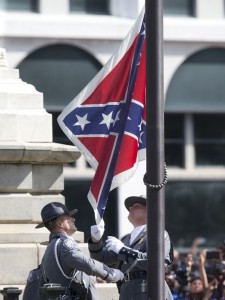
By Bill Fletcher, Jr.
NNPA Columnist
The debate in connection with the flags of the former Confederate States of America (CSA) has unleashed a badly needed debate about U.S. history. As many commentators are noting, for the first time in a long time we are not just discussing whether the flags of the Confederacy offend us, but we are starting to really delve into the history of the Civil War and its aftermath.
The mainstream U.S.A. does not particularly enjoy engaging in discussions about history. Such discussions can become messy and, certainly for much of White America, raise significant questions concerning massive injustices committed against people of color. That said, the question of the Confederate flags has forced to the surface a discussion about the actual nature of the Confederate States of America. It has also forced a discussion about why the Confederate flags resurfaced.
One of the most important debates concerns the role of slavery in contributing to the Civil War. Defenders of the CSA suggest that it was a marginal concern, whereas the historical record – including as documented in speeches by leaders of the CSA – demonstrate the centrality of slavery in the decision to secede from the U.S. But discussions concerning the CSA cannot stop at slavery. Let me give you a few examples of why.
Despite the suggestion that the Southern secession was about states’ rights, what is interesting in the Constitution of the CSA is that there was no provision for secession! Yes, the individual states had a great deal of autonomy, but paradoxically, there was no right to secede from the CSA despite the CSA’s secession from the Union. This is certainly ironic, but it points toward much of the hypocrisy in the CSA’s legacy.
The CSA was not at all a democratic structure. Even leaving the status of slaves aside for a moment, the free flow of CSA citizens was limited based on a pass system. Political parties were banned (though, of course, factions existed) in a fraudulent argument for alleged greater democracy.
There is also the matter of the manner in which the CSA conducted the war, and specifically, the question of prisoners of war. While there were certainly crimes committed on both sides, the CSA carried out purposeful atrocities against Black soldiers and, in some cases, White soldiers who commanded Black troops. The CSA was preparing to issue orders for the execution of Black soldiers until they realized that the North would retaliate in kind.
The CSA, then, was a caricature of the “democracy” that the USA claimed to represent. It cast aside any pretense of an enlightened civilization and represented pure and unadulterated White supremacy.
Beginning in the late 1940s with the rise of the Dixiecrats and later the racist movements against
Civil Rights, the flags of the Confederacy were rehabilitated to represent, not some distorted vision but to actually represent the legacy of the Confederacy. Grasping this history helps us to better understand the movements that fly the battle flag of the Confederacy. It also helps us to understand a point that I never tire of raising: the Civil War never truly ended; it just changed form.
Bill Fletcher, Jr. is the host of The Global African on Telesur-English. He is a racial justice, labor and global justice activist and writer. Follow him on Twitter, Facebook and at www.billfletcherjr.com.








